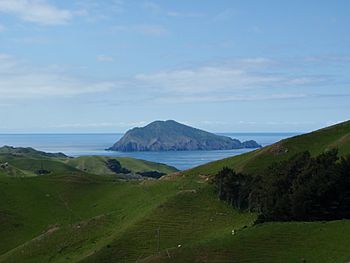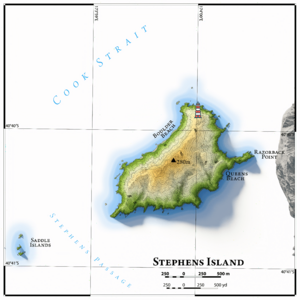Stephens Island (New Zealand) facts for kids
|
Takapourewa (Māori)
|
|
|---|---|

Stephens Island as seen from D'Urville Island
|
|
| Geography | |
| Location | Marlborough Sounds |
| Coordinates | 40°40′S 174°00′E / 40.667°S 174.000°E |
| Area | 1.5 km2 (0.58 sq mi) |
| Highest elevation | 283 m (928 ft) |
| Administration | |
| Demographics | |
| Population | 0 |
Stephens Island is a special island at the very top of the Marlborough Sounds in New Zealand. It's part of the South Island and is about 2 kilometres from D'Urville Island. The island is small, only about 1.5 square kilometres, but it rises high out of the sea, reaching 283 metres tall.
Contents
The Story of Stephens Island
How Stephens Island Got Its Name
Long ago, the Ngāti Koata people, a Māori tribe, owned Stephens Island. They called it Takapourewa, which means "around the tower." This name likely came from the tall lighthouse built there later.
In 1770, a famous explorer named Captain Cook sailed past the island. He decided to rename it Stephens Island. He named it after Sir Philip Stephens, who was an important person in the British Navy.
The Myth of Tibbles the Cat
You might have heard a story about a cat named Tibbles. People once believed this cat caused a small bird called Lyall's wren to become extinct in 1894. But this story isn't quite true! It's more like an urban legend.
While Tibbles did kill one of the last known Lyall's wrens, the bird was already in big trouble. It had disappeared from the mainland a long time ago. This was mainly because of Polynesian rats. Stephens Island was just the last place these birds lived. Many other wild cats were also on the island at that time.
Protecting the Island's Future
For many years, farming on Stephens Island changed the land a lot. About 90% of the original plants were lost. But things changed for the better!
In 1966, the island became a wildlife sanctuary. This means it's a safe place for animals and plants. Then, in 1997, it became a nature reserve. In 2012, the Ngāti Koata tribe and the New Zealand Government agreed to work together. They now manage the island to protect its special nature.
Amazing Animals and Plants
Home of the Tuatara
Stephens Island is super important for nature. Its most famous resident is the tuatara. This amazing reptile is like a living fossil! It's the only survivor of a group of reptiles that lived over 60 million years ago. Tuataras are now extinct on the mainland of New Zealand. Stephens Island is a safe sanctuary for them.
Unique Species Found Here
The island is a special place for many reasons:
- Endemic species: These are plants and animals found nowhere else in the world. They either evolved here or have died out everywhere else. Examples include Hamilton's Frog, which might be the rarest frog in the world. There's also the Ngaio Weevil, a large beetle that cannot fly.
- Rare species: Some animals are only found in a few places, and Stephens Island is a very important home for them. These include the Stephen's Island gecko and the Cook Strait click beetle.
- Lots of common species: The island is also home to huge numbers of common animals. Over a million seabirds live here! You can also find many wētā (large crickets) and darkling beetles.
An Island Connected to the Ocean
Stephens Island is a small piece of land, but it's part of a huge ocean ecosystem. Many seabirds connect the island to the sea. They get food from the ocean and bring nutrients back to the island. In return, Stephens Island offers a safe place for these birds to nest. It's free from land animals that might hunt them.
The Island's Landscape
A Rugged and Wild Place
Stephens Island is a rugged and wild place. It's very much shaped by the sea around it. From the sea, you can easily spot the lighthouse standing tall. Even though no one lives on the island, it has been changed by farming in the past. But it still feels wild and natural.
Marine Life Around the Island
The sea around Stephens Island is full of life. It's a place where many humpback whales travel. You can also see other marine mammals like New Zealand Fur Seals and different kinds of dolphins swimming near the island.
Weather on the Island
This area has strong winds and powerful ocean currents. The sea can be rough and restless. The weather can also change a lot on the island itself. The top of the island is often covered in clouds, while the shores are hit by waves. The western side of the island is more exposed to the weather than the eastern side. On average, the island gets about 800 millimetres of rain each year.
How Stephens Island Was Formed
Stephens Island is made of special rocks called the Stephens Formation. These rocks are about 1100 metres thick and are made of different types of stone, including mudstone and sandstone. They show how the island was formed over millions of years.
The oldest rocks on the island are found at Queens Beach. They are about 150 metres thick and contain rounded stones and larger blocks of sandstone. Scientists have found fossils of ancient sea creatures in these rocks, like brachiopods and bivalves. These fossils tell us that these rocks are from a very long time ago, possibly the Late Permian period. The island also has younger deposits of windblown sand.
Climate
| Climate data for Stephens Island (1981–2010) | |||||||||||||
|---|---|---|---|---|---|---|---|---|---|---|---|---|---|
| Month | Jan | Feb | Mar | Apr | May | Jun | Jul | Aug | Sep | Oct | Nov | Dec | Year |
| Mean daily maximum °C (°F) | 18.8 (65.8) |
19.1 (66.4) |
18.1 (64.6) |
16.0 (60.8) |
14.1 (57.4) |
12.1 (53.8) |
11.2 (52.2) |
11.7 (53.1) |
12.8 (55.0) |
13.9 (57.0) |
15.3 (59.5) |
17.2 (63.0) |
15.0 (59.0) |
| Daily mean °C (°F) | 16.0 (60.8) |
16.5 (61.7) |
15.5 (59.9) |
13.7 (56.7) |
11.9 (53.4) |
10.1 (50.2) |
9.2 (48.6) |
9.5 (49.1) |
10.5 (50.9) |
11.4 (52.5) |
12.6 (54.7) |
14.5 (58.1) |
12.6 (54.7) |
| Mean daily minimum °C (°F) | 13.3 (55.9) |
13.8 (56.8) |
12.9 (55.2) |
11.4 (52.5) |
9.8 (49.6) |
8.1 (46.6) |
7.1 (44.8) |
7.3 (45.1) |
8.1 (46.6) |
9.0 (48.2) |
10.0 (50.0) |
11.8 (53.2) |
10.2 (50.4) |
| Average rainfall mm (inches) | 61 (2.4) |
39 (1.5) |
63 (2.5) |
67 (2.6) |
81 (3.2) |
74 (2.9) |
86 (3.4) |
79 (3.1) |
65 (2.6) |
71 (2.8) |
62 (2.4) |
61 (2.4) |
809 (31.8) |
| Source: NIWA (rain 1961–1990) | |||||||||||||



